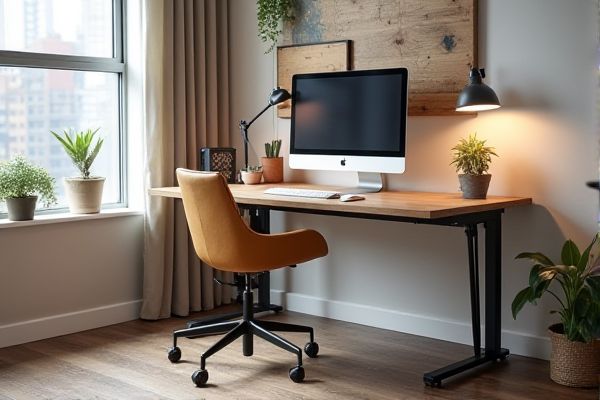
Adjustable desks offer customizable height settings that promote ergonomic comfort and reduce strain during prolonged work hours, while fixed height desks provide a stable, cost-effective solution with a simpler design. Discover which desk type aligns best with Your workspace needs and productivity goals by reading the rest of this article.
Table of Comparison
| Feature | Adjustable Desk | Fixed Height Desk |
|---|---|---|
| Height Flexibility | Height can be adjusted to sit or stand positions | Fixed height; no adjustment possible |
| Ergonomics | Improves posture and reduces strain with customizable height | Limited ergonomic benefits; may cause discomfort over time |
| Price Range | Typically $250 - $1000+ | Generally $100 - $400 |
| Weight Capacity | Usually supports 100-300 lbs depending on model | Varies widely, often supports 150-250 lbs |
| Setup Complexity | Requires assembly; motorized versions need power | Simple assembly; no power needed |
| Durability | Mechanisms may wear over time; warranties vary | Often more durable due to simpler construction |
| Portability | Heavier and less portable | Lighter and easier to move |
Key Differences Between Adjustable and Fixed Height Desks
Adjustable desks offer customizable height settings, promoting ergonomic comfort by allowing users to switch between sitting and standing positions throughout the day, which can reduce strain and improve posture. Fixed height desks have a set height, typically designed for seated use, providing stability and simplicity but lacking flexibility for varied user needs. The choice between adjustable and fixed height desks depends on factors such as workspace requirements, budget, and individual health or productivity goals.
Ergonomics: Supporting Healthy Posture
Adjustable desks provide superior ergonomics by allowing you to switch between sitting and standing positions, reducing strain on your back and neck and promoting a healthy posture throughout the day. Fixed height desks often limit movement and can contribute to poor posture, increasing the risk of musculoskeletal issues. Choosing an adjustable desk supports spinal alignment and reduces fatigue, making it a better option for maintaining long-term health in your workspace.
Productivity Impact: Which Desk Wins?
Adjustable desks significantly boost productivity by allowing users to alternate between sitting and standing, reducing fatigue and improving focus during work hours. Studies reveal that employees using adjustable desks experience up to 45% fewer musculoskeletal complaints and a 15% increase in efficiency compared to those using fixed height desks. Fixed height desks offer stability but lack ergonomic benefits essential for sustained productivity and health.
Space and Design Considerations
Adjustable desks offer versatile space-saving designs by allowing users to switch between sitting and standing positions, optimizing room layout without additional furniture. Fixed height desks provide a stable footprint, making them ideal for minimalistic or limited spaces where consistent ergonomics are preferred. Your choice should factor in the available room dimensions and desired flexibility to maximize both comfort and design efficiency.
Cost Comparison: Upfront and Long-term Investment
Adjustable desks generally require a higher upfront investment, ranging from $300 to $700, compared to fixed height desks that typically cost between $100 and $300. Over time, adjustable desks can save money by improving ergonomics and reducing health-related expenses like back pain and repetitive strain injuries. Fixed height desks may incur additional costs for ergonomic accessories or medical treatments, making adjustable desks a more cost-effective long-term investment for workspace comfort and productivity.
Suitability for Home Office vs Workplace
Adjustable desks offer ergonomic flexibility ideal for home offices where users vary their posture between sitting and standing, promoting comfort and productivity in diverse tasks. Fixed height desks provide a stable, consistent workspace preferred in traditional workplaces with standardized setups and minimal need for posture changes. The adaptability of adjustable desks suits dynamic home office environments, while fixed desks cater to structured office settings focused on uniformity.
User Comfort and Customization Options
Adjustable desks provide superior user comfort by allowing you to easily change the height to suit sitting or standing positions, reducing strain on your back and neck. Fixed height desks lack customization options, often leading to discomfort during extended use due to limited ergonomic support. Prioritizing an adjustable desk enhances personalized comfort and supports healthier work habits throughout your day.
Durability and Maintenance Requirements
Adjustable desks typically feature more complex mechanisms such as motors and joints, which may require regular maintenance and occasional repairs, potentially affecting their long-term durability. Fixed height desks often have simpler designs with fewer moving parts, resulting in lower maintenance demands and generally higher durability over time. Choosing an adjustable desk means balancing the convenience of ergonomic flexibility with the need to monitor and care for mechanical components to ensure longevity.
Technology Integration and Features
Adjustable desks offer superior technology integration through built-in USB ports, wireless charging pads, and programmable height presets, enhancing your workspace efficiency. Fixed height desks typically lack these advanced features, limiting customization and adaptability to evolving tech needs. Choosing an adjustable desk ensures seamless connectivity and ergonomic adjustments tailored to your daily workflow.
Environmental and Sustainability Factors
Adjustable desks promote sustainability by extending product lifespan and reducing electronic waste through versatile usage in diverse environments, unlike fixed height desks that may become obsolete with changing ergonomic needs. You can minimize environmental impact by choosing adjustable desks made from recycled or eco-friendly materials, supporting circular economy principles. Prioritizing adjustable designs also reduces material consumption over time, as one desk accommodates multiple users and reduces the need for replacement.
 homyna.com
homyna.com